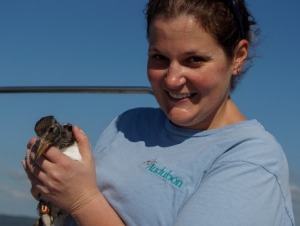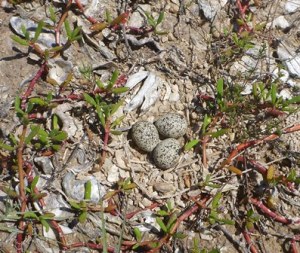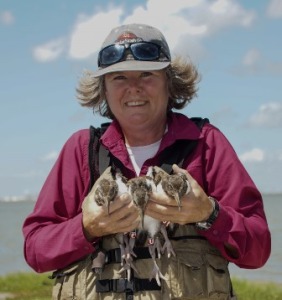By Susan Heath
I am not sure where to begin this week! On Monday I went out to West Galveston Bay and Swan Lake with Amanda Hackney (Audubon TX), Alan Wilde and Debbie Repasz. We began the day by banding two chicks right by the boat ramp. There are two pairs there and each had one chick. Welcome to our oystercatcher monitoring project YX and EU! YX was a little younger than I like them to be for banding but I also don’t like to catch them twice so since it was big enough we went ahead and banded it. Here’s a photo of YX and one of Amanda holding EU.
We headed up to Swan Lake to get that done before the wind picked up. The pairs up there this year are slow getting going but we found two new nests so I guess they are finally getting with it. Back down in West Galveston Bay things starting going a little haywire. First we found two nests I thought had failed with fledged chicks. We never saw a chick at either of these nests which is why I thought they failed but clearly they didn’t. In prior years when we had a grant to cover this project, I or my graduate student was checking on all the nests at least once a week and sometimes twice a week so we had many opportunities to discover what the oystercatchers were trying to hide from us. This year with only going out once every two weeks, it is difficult to assess what’s happening sometimes. These pairs kept their chicks well hidden while we were around! So these chicks will remain unbanded since there’s no way to catch them once they can fly.
The next surprise came when I discovered that a pair that I thought was laying sterile eggs, turned up with a nearly fledged chick. This pair nests in the middle of a large Laughing Gull colony and each year they would lay three nests (once four) and we never saw them with a chick so I figured something was wrong with the eggs. Well this year a huge flock of Royal and Sandwich Terns has displaced the Laughing Gulls and viola, T5 & T6 suddenly are able to fledge a chick! That just goes to show the negative effect of the gulls on oystercatcher productivity. We banded their chick EX and moved on.
When we got to South Deer we got another big surprise. Last time we banded what we thought was the only chick of L2 & unbanded. When we went to check on them, we found an unbanded pair of adults and an unbanded fledged chick. What?! I quickly surmised that they actually had two chicks and we didn’t band the one we were seeing now, but where was the banded chick and where was the banded adult? I began searching the shoreline through my binoculars for the banded chick and noticed something that looked like a dead adult laying along the shoreline. We went to check and sure enough it was L2. Poor guy. It was not apparent what happened to him so I took his body to a rehabber friend of mine. She said he had been dead about three days and was severely emaciated as if he hadn’t eaten in two weeks or so. The only thing we can figure is that he was injured somehow, perhaps to his eyes because she didn’t find any wing injuries and was then unable to feed himself so he starved to death. Ugh. A sad ending for a bird I have watched thrive for four years. His unbanded mate must have already acquired a new mate which was why there was a pair of unbanded birds. I have seen this before. When something happens to an adult, the widow or widower often has a new mate within 2 weeks. There must be a singles oyster bar out there somewhere! This is what leads me to believe that habitat is a limiting factor for oystercatchers in Texas because there are always available adults ready for pairing.
Anyway, we didn’t find the banded chick so I assumed it had died and we moved on to the pair next door (L0 & unbanded) because they had a chick that needed to be banded. We found L0 and a chick but the chick was banded. What?! It was L2’s chick (YT) that we had banded last time. Wow. I know what you’re thinking. The chick we banded was really L0’s and we made a mistake but I don’t think that’s possible. The chick we banded was found where L2’s chicks always are and L2 and mate were standing very close to where we found it. I can only surmise that as L2’s health declined and he was unable to feed himself or help feed the chicks, his mate was unable to feed both chicks and YT wandered down to L0’s territory and L0 adopted it. I would never have expected that to happen because I have seen adult pairs attack the chicks of other pairs but the oystercatchers are always surprising me. Anyway, we caught L0’s chick and banded it EY. Little YT could almost fly so I hope L0 & mate continue to feed it so it can fledge. That would be a fantastic story!
After all that excitement the rest of the day was tame. We found three more new nests, all renests from pairs that failed. Amanda found a Wilson’s Plover nest which is something I’ve never seen so that was pretty exciting and we rescued a male Diamondback Terrapin that was stranded on shore with one foot dangling by dead skin. Here’s the Wilson’s Plover nest.
Amanda took him to the Houston Zoo on advice from folks at The Wildlife Center of Houston and the head vet there operated on him and they think he will be just fine after a round of antibotics to fight of any infection. Diamondback Terrapins can apparently survive just fine without a limb. Our last task of the day was to band three chicks that belong to P3 & unbanded. P3 & unbanded fledged three chicks last year so for them to fledge three chicks again this year will be a herculean feat but they appear to be doing just that. Catching three chicks is quite a chore but Alan and I managed to scoop all three of them up with dip nets before they could swim too far way. All three were doing fine and their weights were pretty similar so they must all be getting enough food. We banded them FW, FU, and KU. It was a good way to end a crazy day when the oystercatchers once again taught me that they still have a few tricks up their bills.
On Wednesday I went out to Drum and Bastrop Bays with Pete and Peggy Romfh. If you’ve been reading along, you’ll remember that all the nests in these bays were destroyed by a hail storm and I was expecting to find a whole new crop of nests today. Well that didn’t happen because the tide was super high and most of the nesting areas were underwater. It is entirely possible that they laid new nests that were overwashed between the last time I was out (2 weeks ago) and now. Most of the oystercatchers weren’t there. We found only one pair in Drum Bay but they didn’t have a nest. We found one pair in Bastrop Bay that did have a new nest but the wind was washing the waves up against a shell berm along the edge of the island and that was splashing water onto the eggs. It wasn’t clear whether the oystercatchers were incubating the eggs or not but the eggs did appear wet so I doubt that nest will survive. These birds really have it tough!
Later that day I did a shorebird survey along the beach near this bay and I discovered one of the pairs from this bay only it was a new pairing. 30 & AR were hanging out together on the beach. 30 has always been paired with K1 and they already had a nest that failed this year. AR was the mate of K0 last year but we have not seen her this year and K0 is paired with an unbanded bird. I guess K1 either left or something happened to her because it appears that 30 is now paired with AR. The oystercatcher soap opera continues!
On Thursday I went out to East Matagorda Bay with my significant other Tad Finnell and Billy Ward, the technician from TNC’s Mad Island Marsh Preserve. Billy has wanted to go out with me for a while now and I was glad to finally get to take him. Since there were two chicks on one island that needed to be banded, I figured I needed some more help and Tad was happy to help. We started the day by finding one of the chicks we banded last time AY sitting on an island all by itself and not the nesting island either. It is highly unusual for a chick this young to be separate from its parents but since I didn’t know the scoop, I figured we’d better leave well enough alone. Maybe they were off getting food or something. The sibling of AY was not there though, which was also strange. The tide was still really high and AY’s hatching island was really small so I suspected it might be underwater. We checked on the pairs in that area and found all was well with the other two pairs (one has three fledged chicks and the other has two) but AY’s parent were not on their nesting island and neither was the other chick AX. The island was nearly underwater but there was still a small scrap of it standing above the water line. Not good. I decided we’d check on the situation when we came back by after doing everything else. All was well with the pairs out at the Oyster Farm. Both have one chick which will need to be banded on our next outing. At Old Gulf Cut there are two pairs of adults and I thought one had one chick and the other had two chicks. Well surprise! They both had two chicks! We caught all four of them and banded them without incident (always what I hope for when catching and banding chicks). Here a photo of Billy holding one set.
We then headed back down the GIWW to check on AY again. It was still sitting there but this time I thought I could see the adults back on the nesting island. We motored out there and sure enough they were there. I thought maybe the tide had washed AY off the island they didn’t know where it was so we went back with the intention of catching AY and taking it back to the adults. Well little AY was having none of that. When we got close it took off flying and flew way down the GIWW where I couldn’t follow it in my binoculars anymore. So much for good intentions. I really hope it finds its way back to its parents because a just fledged chick does not have much of a chance for survival without them for protection and help with feeding. I will be elated if we find them all together when we return in two weeks. There was no sign of AX so I have to assume that it died. While we were on the island with AY, Billy discovered this bad boy sleeping off a big meal.
We left it there even though there was a Willet nest a few feet away. Sorry Mr. or Mrs. Willet. I would like to have saved your nest but I’ve had a few too many close encounters with Mr. Rattlesnake to take a chance with this one. We will check on the Willet nest next week and see if it was spared.
Current Stats: 8 nests being incubated, 25 failed nests, 14 nests with unfledged chicks, 4 nests with undetermined status, 14 chicks fledged
Just a reminder that we have banded chicks up for adoption now. I haven’t had time to put them up on the adoption page but if you’d like to adopt one just send me an e-mail (sheath@gcbo.org) and I’ll hook you up. We have chicks in West Galveston Bay and East Matagorda Bay.
If you just want to donate you can do that through our Just Give portal. In a couple weeks we should have some chicks ready for adoption!
Filed under: Birding
![]()










